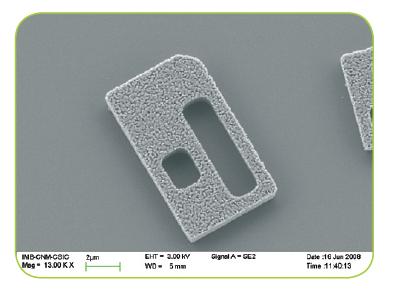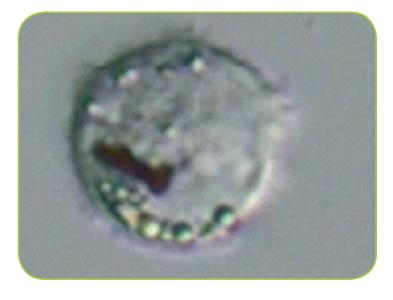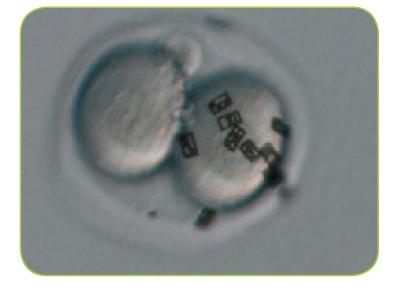Έπιστήμονες ‘εμφυτεύσαν Έτικέττες μέ Bar Code σέ έμβρυα
Αυτό ακριβώς έκαναν οι ερευνητές στο αυτόνομο πανεπιστήμιο της Βαρκελώνης (Autonomous University of Barcelona) http://www.uab.es/english/ όπως περιγράφει το New Scientist. .
.
Χρησιμοποιώντας τα κύτταρα από τα έμβρυα και τα αυγά ποντικιών, οι
επιστήμονες ανέπτυξαν μια διαδικασία που περιλαμβάνει την εμφύτευση
μικροσκοπικών Bar Codes από πυριτίο σε ένα χάσμα μεταξύ της μεμβράνης
κυττάρων και μια εξωτερική μεμβράνη που ονομάζεται προστατευτική
ζώνη (pellucida zona).
.
Το επόμενο βήμα είναι να δοκιμαστεί αυτή η τεχνική σε ανθρώπινα έμβρυα.
.
Αυτός θα συμβεί σύντομα, το τμήμα υγείας της Κυβέρνησης της Καταλωνίας ( Government of Catalonia’s Department of Health) έχει εγκρίνει ήδη τη μέθοδο για τη χρήση στο γενετικό υλικό που παρέχεται από τις ισπανικές κλινικές γονιμοποίησης.
.
Η τεχνική ισχυρίζονται θά τούς βοηθήσει στην Ταυτοποίηση τών
Έμβρύων ώστε να αποφύγουν λάθη στην εξωσωματική γονιμοποιήση, όπως αυτο
τού 2002, πού μπέρδεξαν το γενετικό υλίκό, με αποτέλεσμα ζευγάρι λευκών
να γεννήσει μαύρα δίδυμα. !!!!
.
Πηγές
.
.
.
.
.
.
ΑΥΤΟΝΟΜΟ ΠΑΝΕΠΙΣΤΗΜΙΟ ΒΑΡΚΕΛΩΝΗΣ
Universitat Autonoma de Barcelona, Consejo Superior de Investigaciones Científicas (CSIC)
Fig. 1 A scanning electron microscope image of a barcode.
Η εικόνα του barcode όπως φαίνεται μέ ένα ηλεκτρονικο μικροσκόπιο.
Fig. 2. Light microscope micrograph of an in vitro cultured
macrophage cell with polysilicon barcode. Picture was taken with a 40x
objective on an inverted optical microscope
Μικρογραφία από μικροσκόπιο ενός τεχνητά καλλιεργημενου μακροφάγου κυττάρου, μετά την εμφύτευση barcode, από πολυπυρίτιο.
Fig. 3. Light microscope micrograph of a mouse embryo at the
two-cell stage with different polysilicon barcodes adhered to the zona
pellucida. Picture was taken with a 20x objective on in inverted optical
microscope.
Μικρογραφία από μικροσκόπιο,
ενός εμβρύου ποντικού στο στάδιο ανάπτυξης των 2 κυττάρων ( ΕΜΒΡΥΟ ΜΟΝΟ
ΜΙΑΣ ΗΜΕΡΑΣ) !!!! με πολλά καί διαφορετικά barcodes εμφυτευμένα !!!!,
στην προστατευτική ζώνη (pellucida zona) του κυτάρρου.
.
Diverse types of barcodes have been designed in order to track
living cells in vivo or in vitro, but none of them can follow an
individual cell up to ten or more days. Until now, codes have been
envisaged to follow different
cell subpopulations mixed in the same culture, to track a minority group of cells representing the whole population or to follow a subpopulation of cells in vivo.
cell subpopulations mixed in the same culture, to track a minority group of cells representing the whole population or to follow a subpopulation of cells in vivo.
.
Individual cell tracking is important to
evaluate individual cell behavior (cell survival, cell movement,
relationship with other cells, etc.) under different conditions
(exposure to toxic gases or compounds, therapeutic drugs, source of
light, a chemical stimulus, etc.). Individual cell tracking is also of
great interest in embryo traceability in assisted reproduction
technologies (ART) to make sure that the embryo to be transferred
belongs to the right couple.
A biocompatible and non-cytotoxic encoded microparticle has been
developed to track isolated cells or embryos. It is an useful tool in
research to follow the behavior of individual cells exposed to different
conditions or different therapeutic drugs and in clinical settings to
track individual oocytes and embryo as well. We are seeking a company
partner to further develop the technology through a co-development and
license agreement.
The invention
A biocompatible and non-cytotoxic encoded microparticle for
labeling or tracking an isolated cell (e.g. macrophages, fibroblasts,
ESC or oocytes) or an isolated embryo has been developed. The
microparticle is made of a biocompatible material using silicon
microtechnologies. This technology allows the production of thousands of
barcodes containing different codes. Its external shape comprises a
code by which it can be identified using an inverted optical microscope
with an objective between 20X – 100X. Its dimensions are small enough
that it can be introduced into or attached to isolated cells or embryos.
Contrary to previous labeling and tracking devices, the code of the
microparticle is comprised in its external shape. The code of the
particle may thus be considered a spatial code. There is no need for
fluorochromes to be able to identify the code.
Innovative aspects and applications
- Encoded microparticules as a High throughput screening cells tool.
- Encoded microparticules for tracking human embryo in IVF treatment.
- Biocompatible and no cytotoxicity.
- Adherence to zona pellucida or plasma membrane .
- Optical microscopy code identification.
- Low-cost manufacture and high versatility.
- Encoded microparticules for tracking human embryo in IVF treatment.
- Biocompatible and no cytotoxicity.
- Adherence to zona pellucida or plasma membrane .
- Optical microscopy code identification.
- Low-cost manufacture and high versatility.
State of development
- Barcodes have been tested in cells (macrophages) and in mouse embryos.
- Studies of Biocompatibility and cytotoxity have been carried out in macrophages and mouse embryos (during the pre-implantation development, from zygote to hatching stage).
- Barcodes are made using silicon microtechnologies (MEMs and NEMs fabrication) which allow the production of the devices with dimensions in the micron range.
- Studies of Biocompatibility and cytotoxity have been carried out in macrophages and mouse embryos (during the pre-implantation development, from zygote to hatching stage).
- Barcodes are made using silicon microtechnologies (MEMs and NEMs fabrication) which allow the production of the devices with dimensions in the micron range.
Ongoing research
- Adherence to plasma membrane. Results are expected at the end of the second quarter of the year.
- In vivo studies in mouse. Results are expected within the last quarter of the year.
- In vivo studies in mouse. Results are expected within the last quarter of the year.
Κατεβάστε το εδώ
.
ΠΑΝΕΠΙΣΤΗΜΙΟ ΟΞΦΟΡΔΗΣ – ΑΝΘΡΩΠΙΝΗ ΑΝΑΠΑΡΑΓΩΓΗ
Oxford Journals - Human Reproduction
A novel embryo identification system by direct tagging of mouse embryos using silicon-based barcodes
Τεχνική Ανάλυση τής μεθόδου







Δεν υπάρχουν σχόλια:
Δημοσίευση σχολίου